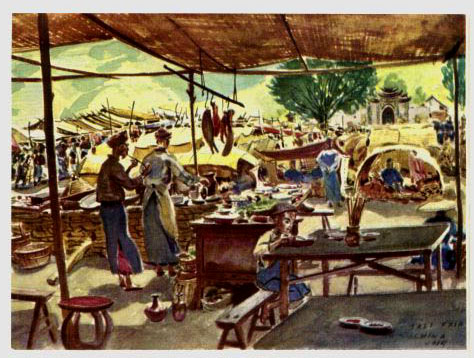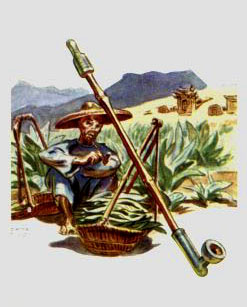"Making
travel sketches pay"
by Norman
Saunders
Having known
Norman Saunders almost since he left high school, and since he
graduated from both our art courses in the twenties, this writer
feels very close to the artist. He studied our courses while
living in Roseau, Minnesota, way up north near the Canadian border.
He had talent and worked very hard at it. We arranged his first
interview with the art director of fawcett Publications and it
was there that he obtained his initial experience in magazine
illustration work. In the early thirties he decided to try his
art wings in Chicago, but at this writer's insistence, went to
New York. He still reminds me that I promised to pay his fare
back to Minneapolis in the event that he did not make good in
the big city. I am enough Scotch to be glad that I did not have
to buy his return ticket, in fact had so much faith in Norm that
I did not even reserve space in a box car for him. Though he
is chiefly known as a cover artist, which work keeps him busy
in his New York studio, he has written and illustrated numerous
articles for magazines about his sketching experiences in China
and Tibet, while soldering in these places during the second
world war. We think that his sketches in water color are not
only his top work, but some of the finest art work brought back
by our soldier artists. Because of this, we asked Norm to write
this article and we feel very fortunate to be able to reproduce
a few of these art gems in this magazine. - Editor

All you need in order
to turn your road to financial independence into a pleasant sketching
trip are strong arches, an alert mind (whetted razor-sharp by
ART INSTRUCTION, INC.), a supply of pencils (Prismacolor No.
935), a couple of sketch pads, a small box of water colors, and
a few assorted brushes.
The ability to
sketch accurately and quickly is of vital importance to a successful
career in art. Constant use of this ability will sharpen your
perceptions, broaden your general knowledge, stimulate your curiosity,
and in turn develop your latent talents.
Now is the time
to start and your own locale is the place.
I started sketching
up in Northern Minnesota, upon learning that Walter Wilwerding
had financed a trip to Africa with his sketches and paintings.
Everything was
and is gist to my mill. Opportunity, I have learned, hides everywhere--even
on a bleak mountainside in western China. lacking anything exciting
to sketch, I was diligently filling a page with color notes of
indigenous plants and shrubs, when I noticed a small field of
Asiatic tobacco under cultivation. Upon completing a detailed
drawing of one of these plants, I looked up and into the eyes
of an ancient Oriental, who apparently had materialized in the
haze of his smoking pipe.
The sketch of
this contemplative tobacco grower was followed by a picture of
a small donkey bound for a nearby village with a load of cured
tobacco. Then I found auctioneers, warehousemen, and sundry experts
- all of them preferring American cigarettes and tobacco, incidentally.
Alerted to the
possibility inherent in the subject, it was only a matter of
time and patience to complete a series showing the major steps
in the growth and processing of tobacco in China. this led quite
naturally to a collection of smokers and their pipes. The portfolio
was topped off with a couple of opium addicts replete with pipes
and dreams. (The story as a whole was tied up with the wartime
tobacco shortage back in the United States.)
This sketching-for-profit
is an insidious process--and pleasant. Following one idea, you'll
find a dozen others luring you on. I was on the lookout for unusual
pipes when I discovered a hand-cast aluminum pipe of local manufacture.
After sketching it and questioning its owner, I was able to locate
the smelter where it had been cast, in an adjacent village. This
smelter was supplied with aluminum by a struggling line of industrious
Chinese coolies who were mining it from the hull of a C-46 which
had crashed recently in a local rice paddy. Their ingenuity had
turned this defunct airplane into a high-grade bauxite mine for
them--and a small gold mine for me. Sketching and inquiry led
me to so much material that I was able to compile a story on
"Yank Ingenuity" which I sold to Mechanix Illustrated
magazine

While collecting
information on that article, I was catapulted into another story
when I discovered that China is the graveyard of punctured gasoline
drums. These drums hide in the kitchens or the highways under
strange disguises. They stock hardware stores, afford shelter,
make cooking utensils--their uses are endless. They even provided
me with enough material to sell another story to Fawcett Publications.